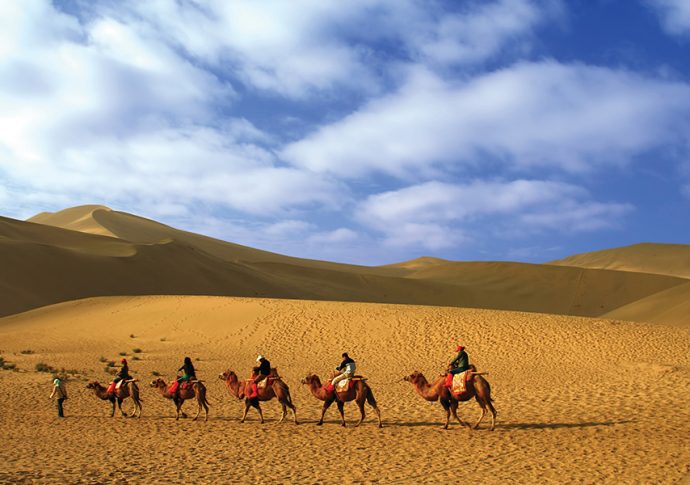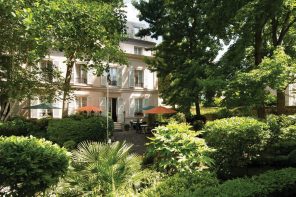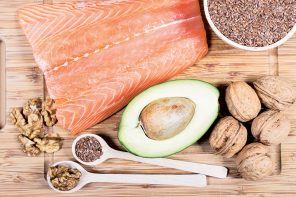If any place deserves to be haunted, it is the Old Silk Road, for along its ancient routes there have occurred more mysterious happenings, rich pageantry, magical rituals, sinister intrigue, epic battles and cruel massacres than mortal imagination can encompass.
The ghosts of the past, however, are giving way to modern globalism as the legendary Old Silk Road that once joined Imperial China to the Roman Empire is morphing into a New Silk Road. The global project was envisioned by China’s President Xi (pronounced “She”) Jinping in 2013 when he revealed his “China Dream,” dubbed “One Belt, One Road” (OBOR), which, according to The New York Times, “… is aiming to create a new kind of globalization that will dispense with the rules of aging Western-dominated institutions.” For centuries, the iconic mile-long camel caravans connected Chinese traders with buyers in the Middle East and Europe by way of the Eurasian steppes, Palestine and Turkey. Today the reincarnated, embryonic initiative looms at a scope and scale unprecedented in modern history involving more than $1 trillion in infrastructure and spanning more than 60 counties. If delivered as planned, it would create a global building spree and the greatest travel event on earth.
The One Belt refers to a land-based Silk Road Economic Belt from China to Europe, One Road symbolizes Beijing’s concept of a “21st century Maritime Silk Road stretching from Australia to Zanzibar. Ships will sail from Guangdong and other ports on China’s southeastern seaboard through the Indian Ocean, along the east coast of Africa to the Red Sea, through the Suez Canal to the Mediterranean Sea, ending in Venice. As Pepe Escobar wrote in The Nation: “Think of it as Marco Polo in reverse.”
The plan has had Xi — whose wife is the contemporary folk singer Peng Liyuan — turning to musical metaphors to describe its benefits, equating his plan to a symphony of economic cooperation. Xi’s dream reached a crescendo of sorts when he hosted world leaders, including Vladimir Putin, from 30 countries for a two-day “OBOR Summit” May 15 and16 to discuss his globalization blueprint and trade agreement. China insists that its initiatives will benefit all of humanity. “One Belt, One Road” will create a kind of Pax China through everything from pipelines to ports backed by Chinese money and industry. Domestic companies will find new markets, and recipient nations will have a source for much-needed investments. Yu Xiaoxian, a businessman with six companies playing on the OBOR brand, said the plan will help big and small investors: “When big rivers have water, small streams are also full,” he told The Wall Street Journal.
The grand scheme could reshape the economic order in Asia, create incentives for the global economy and reinforce regional ties among countries. The project will recreate the land and maritime trade routes that centuries ago were the network of overland routes used by silk traders and others to transport merchandise from China to northern Europe, Rome and Venice via Central Asia and the Middle East. Another branch will convert the Trans-Siberian Railway into a rapid rail line, cutting the travel time between Beijing and Moscow from 156 hours to 33, with Moscow as a key hub. The train travel from China to Europe would be cut from 21 to two days — compared to several years on the Old Silk Road. The high profile initiative is slated to be completed by 2025 and will, according to Xi, “answer the call of our time for regional and global cooperation.”
According to diplomats, China received support for most proposals but failed to secure European endorsement of a planned statement on trade. France wanted more transparency about stakeholders and reciprocal market access. Daniel Rosario, the EU spokesman on trade, said the bloc couldn’t support the trade agreement. The United States echoed European attention to international fair trade rules, adding that ensuring transparency in bidding “would benefit Silk Road projects.” Robert Hormats, vice chairman of Kissinger Associates, advised the U.S. to find ways of working with China as the initiative is “very comprehensive, visionary and historically important.”
In this implementation of soft power, China intends to support partner countries and improve connections with Central Asia, the Middle East and Europe. Some economists question if China’s global development is financially sound. Chinese experts proposed a diversified financial system to link more than 60 countries. The Export Import Bank of China loaned $80 billion; Asian Development Bank, $27 billion. “The new kid on the block,” New Asian Infrastructure Investment Bank (AIIB), China’s answer to the World Bank, advanced $100 billion. In spite of American reluctance, at least 65 countries are included in the OBOR initiative, and 47 have joined as founding shareholders.
Already projects worth more than $900 billion are underway. A February report of “Meeting Asia’s Infrastructure Needs” estimated costs of $26 trillion. Western companies, including General Electric and Honeywell, are angling for a piece of the action. Honeywell hopes to obtain contracts from oil deals and infrastructures like hotels relying on Honeywell services. GE Vice Chairman John Rice said that OBOR should boost sales by $5 billion annually. Chinese officials estimate that it should create $10 billion to $20 billion annual in sales for companies. Wang Min, chairman of China’s largest manufacturing company, said the project makes them feel “like a tiger with wings.”
China’s Dream was launched two years after President Barack Obama initiated the Trans-Pacific Partnership (TPP), a trading bloc around the Pacific Rim. Now that President Donald J. Trump has withdrawn from TPP, the expectations are that OBOR will expand China’s economic and geopolitical sway across the Middle East, Europe and Africa. With the TPP in trouble, OBOR — and China — become more important.




